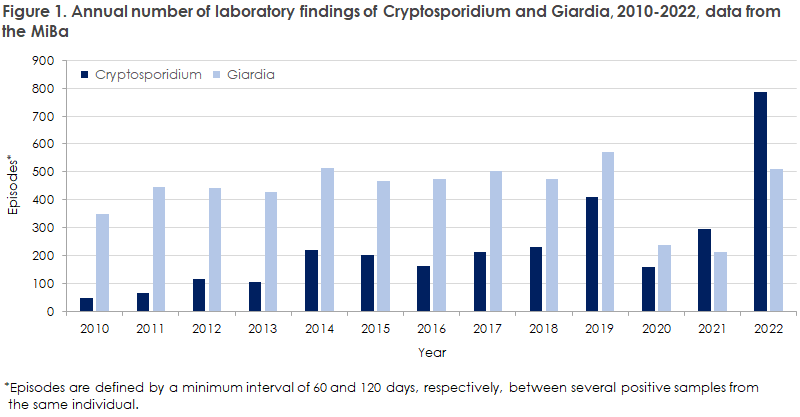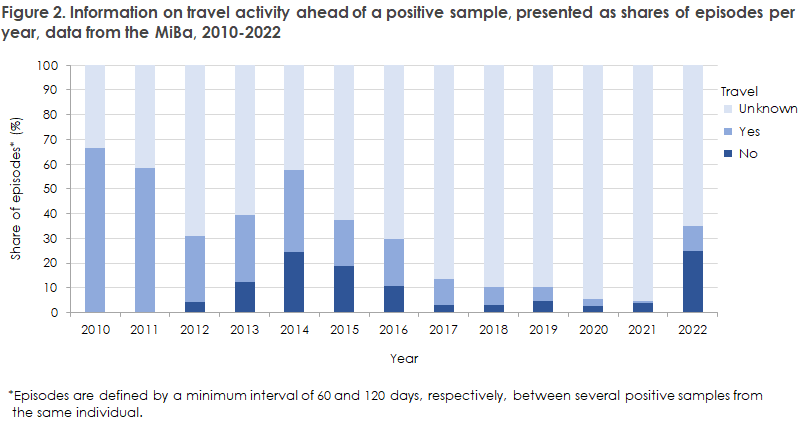No 26b - 2023
Increase in the number of identified Cryptosporidium infections acquired in Denmark
Increase in the number of identified Cryptosporidium infections acquired in Denmark
In 2022, more persons had Cryptosporidium detected than ever before in Denmark. This increase probably due to changes diagnostic methods rather than a genuine increase in infections. In 2022, infection with Cryptosporidium was acquired more frequently in Denmark than abroad according to data from the MiBa. Previously, only a limited number of species (C. parvum, C. hominis, C. meleagridis) had been identified in Denmark. However, in 2022, many different species and subtypes of Cryptosporidium were recorded.
Cryptosporidium which has previously been considered a rare cause of gastrointestinal infection acquired in Denmark, beknow appears to be relatively common. The population of Cryptosporidium parasites is diverse, and the sources of infection and transmission routes are not well understood at present In Denmark, findings of Cryptosporidium in humans are not currently notifiable to the SSI.
We expect cryptosporidiosis to be included in the next revision of the executive order by the Danish Health Authority on doctors’ notification of infectious diseases.
What is Cryptosporidium?
The term cryptosporidiosis denotes a symptom picture caused by infection with the unicellular intestinal parasite Cryptosporidium. The primary symptoms are diarrhoea, which may be severe, and abdominal pain, fatigue and, in some cases, nausea. Symptoms may last for up to several weeks. In developing countries, cryptosporidiosis is an important cause of severe diarrheal disease, particularly associated with morbidity and mortality in infants and young children Additionally, it is well-described that immuno-suppressed individuals may experience serious disease.
Previously, Cryptosporidium was not considered a major cause of diarrhoeal disease in Denmark. This may have contributed to a low prioritisation of pathogenic intestinal parasites in standard diagnostics. In Denmark, cryptosporidiosis in immuno-competent patients is considered self-limiting, but some may require hospitalisation for symptomatic therapy.
Identification of sources of infection is difficult as Cryptosporidium may infect a wide range of animal species, which may, in turn, transmit the condition to the environment via oocysts excreted with faeces. Oocysts are a type of resistant spores that can survive chlorine treatment, and that may survive for prolonged periods of time in the environment. Furthermore, the infectious dose of oocysts is low, and the incubation period is typically 7-10 days. No cryptosporidiosis vaccine exists at the moment, and the treatment options are limited to Nitazoxanide (an authorisation-only drug), which may have some effect in immuno-competent adults and children > 12 months of age.
Outbreaks may be overlooked
In Norway and Sweden, surface water is often used for drinking water, and water-borne Cryptosporidium transmission has therefore caused very large disease outbreaks in those countries. Denmark has previously recorded small outbreaks among veterinary students who had handled calves, as well as a limited number of small food-associated outbreaks and outbreaks among immuno-compromised persons. However, it seems likely that not all outbreaks were acknowledged.
Increase in Cryptosporidium in 2022
Before 2021, Giardia was the most frequently detected enteropathogenic parasite in Denmark, but in 2021 it was surpassed by Cryptosporidium, see Figure 1. The 2020-2021 period was characterised by the COVID-19 pandemic and derived restrictions. In this period, fewer parasitic, bacterial and viral gastrointestinal infections were detected. In 2022, Giardia returned to its pre-pandemic level, whereas Cryptosporidium caused nearly 800 episodes - a marked increase compared with the preceding years. The explanation for this increase is that the departments of clinical microbiology (DCMs) in Slagelse, Odense, Herlev and, more recently, Aalborg, have introduced a new IVDR-approved diagnostic PCR panel targeting enteric pathogens. This means that all - or nearly all - faecal samples examined at these DCMs are now tested for the same enteropathogenic parasites, bacteria and viruses without any need for a specific requisition from the treating physician. Cryptosporidium detected in patients who undergo this type of work-up are presumably - in full or in part - the cause of their symptoms. However, the prevalence of Cryptosporidium in asymptomatic individuals remains unknown.

More cases acquired in Denmark
Information about travel history is available in MiBa, provided such information was stated on the original sampling requisitions, Figure 2. However, the information on travel activity is not comprehensive as patients’ travel history is not stated in a standardised manner in all regions, and because cryptosporidiosis has not yet been subjected to national surveillance. Even so, 2022 recorded more Cryptosporidium-positive samples in the MiBa from patients who had not travelled abroad (25.0%) than from patients who had travelled abroad (10.2%), whereas no information was provided on travel history for 64.8% of cases.

Many different species and subtypes of Cryptosporidium recorded in 2022
Danish DCMs can submit samples that have tested positive for Cryptosporidium to the Parasitological Laboratory, SSI, for species determination and additional typing. Subtypes of Cryptosporidium species may be determined by specific analysis of the gp60 gene. In 2022, approx. 25% of the positive samples were submitted to the SSI and around 80% hereof could be typed.
In a previous report on typing findings from the SSI, only subtypes of C. parvum and C. hominis were identified, along with a single case of C. meleagridis. In contrast, in 2022, species and subtypes identified that had not previously been recorded in Denmark. While the majority of 2022 samples still consisted of C. parvum, there was significant diversity of subtypes within this species.
Furthermore, other examples of zoonotic transmission were observed; from hedgehogs (C. erinacei), chipmunks e.l. (C. chipmunk, genotype I) and mice (C. ditrichi and C. tyzzeri). Cryptosporidium hominis, which is primarily transmitted between humans, was observed only in very few cases in 2022.
Read more about the reference analysis performed by the SSI on the positive samples submitted for typing in the diagnostic manual at the SSI website.
Read more about cryptosporidiosis in the disease encyclopaedia on the website.
(T. G. Larsen, S. Ethelberg, Department of Infectious Disease Epidemiology and Prevention, M. Zangenberg, C. R. Stensvold, Department of Bacteria, Parasites and Fungi, J. Kähler, DIAS, J. Engberg, DCM Køge, Region Zealand, G. N. Hartmeyer, DCM Odense, Region of South Denmark, L. Lützen, DCM Vejle, Region of South Denmark, H.L. Nielsen, DCM Aalborg, North Denmark Region, L. Nielsen, DCM Herlev, Capital Region of Denmark, L. Erikstrup, DCM Aarhus University Hospital, Central Denmark Region)
28 June 2023